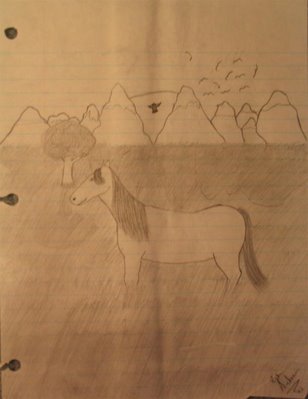To start us off, I was able to find a rare sketch (worth millions, I'm sure) from the artist as a 10-yr old.
 The horse motif is found in many of the artist's early works, primarily because every little girl wants a pony. Or perhaps there was greater meaning. The horse. Wild. Free. Fuzzy.
The horse motif is found in many of the artist's early works, primarily because every little girl wants a pony. Or perhaps there was greater meaning. The horse. Wild. Free. Fuzzy.But first let's discuss the artistry at face value. The horse is generally proportionate, though there is a surreal quality about it. The landscape, though dimensional, seems to be made up of three very specific planes: the horse, the tree, and the mountains. The only indication that these planes comingle is the suggestion of shadows being cast by the tree and mountains into the plane in which the horse resides. The horse, it seems, defies shadows.
There are two types of birds. First, there is the eagle/phoenix rising sort of bird, which seems to suggest that the artist saw too much Western art. Then there is the flock of birds, who are suspended in buzzard-like circling. The eagle obviously represents life and vitality. The buzzards, death. However, because the eagle is centrally placed over the horse, we understand that the artist is further emphasizing the wild, free nature of the horse, and the buzzards are there only to provide greater contrast.
Yet, we will notice that the "wild, free" horse is standing quite still, not partaking in its freedom to run. Perhaps he is frightened by the buzzards?
Obviously, the artist is repressed at the time of this sketch. Her wild spirit is being stifled deep inside of her, and her innocent pencilling is a cry for help. She stands still, afraid of the possibilities, yet she longs to be the great eagle, and fly above the shadows. This artist is most definitely a deeply troubled person.
Either that or she was in desperate need for some art classes.













I remember the artist drawing me a picture almost exactly like this during an algebra class.
ReplyDeleteI agree that, in fact, this work does show early potential. Depth and shadow were very underutalized. But there was scope and size clearly taken into consideration.
It is fascinating to see where someone begins and where they are are present. Wonder what they will say about Mrs. Dickinson Norvell long after she is gone -- the next Monet?
I told you it was a motif! I liked horses. Maybe because it was the only thing I could draw. Well, that and the Teenage Mutant Ninja Turtles.
ReplyDeleteThat horse far surpasses any horse I have ever drawn or ever will draw. I cannot draw four legged animals at all. They always look like a cloud with four legs!
ReplyDeleteif it might be worth millions one day...can I have it? I'll give you $10 now for it!!!
ReplyDeleteI enjoyed the artist's explanation of the various elements of the work. Now I have a greater understanding of the depth of the artist's ability as demonstrated in this work. Bravo! (or is that only for operas?)
ReplyDeleteThe horse is smiling... I think it's content, not afraid.
ReplyDeleteI used to draw horses, too, AND ninja turtles. And I didn't do too bad if I might say so myself. But I didn't develop that talent, well, if it ever was a talent at all.
The smile is a forced smile.
ReplyDelete"I'm a happy horse...very alive....DON'T EAT ME!!!"
But those buzzards are far away, and they are concerned with something else. Maybe the horse is smiling mischievously because he killed the animal the birds are preying on. Maybe you were taking out some childhood aggression because you were otherwise seen as a "compliant child" yet you received no recognition from your brother, and you just wanted to break out of the mold... but without too severe of consequences, so you expressed said desires in this seemingly harmless picture of a horse.
ReplyDeleteHorses don't kill animals! That's awful! This interpretation has gone all wrong!
ReplyDeleteThe artist herself gives an interpretation, and people counter it with alternative interpretations. Typical!
:)
So... is art about what it initially spoke to the artist or how it continually speaks to the viewer?
ReplyDeleteOh, and let me remind you that you said, "I welcome any 'interpretations' you may have of the work."
ReplyDeleteDon't say it if you don't mean it. :-)
*Sigh... That was for the NEXT artwork! I was getting us started with this one! :) Always misunderstood, we artists!
ReplyDeleteAnyway, horses still don't kill animals. You should know enough about the artist that THAT wouldn't be in there!
As for interpreting art, it is an age-old question whether the interpretation comes from the artist or the viewer. I think that if the artist has written about the art himself, then that should be considered the primary (if not sole) interpretation.
However, what I've written is purely in fun, so I suppose if you want to see horrors such as horses killing other animals, you may do so. :)
Part 2 is on the way!
Admit it... you don't really want anyone's interpretation rather than your own. Might you rephrase that in your next post?
ReplyDelete